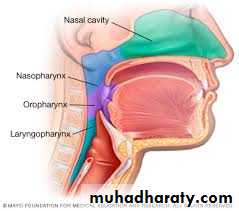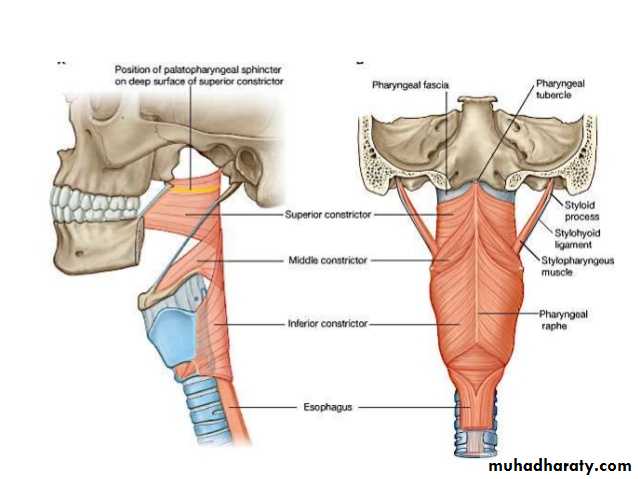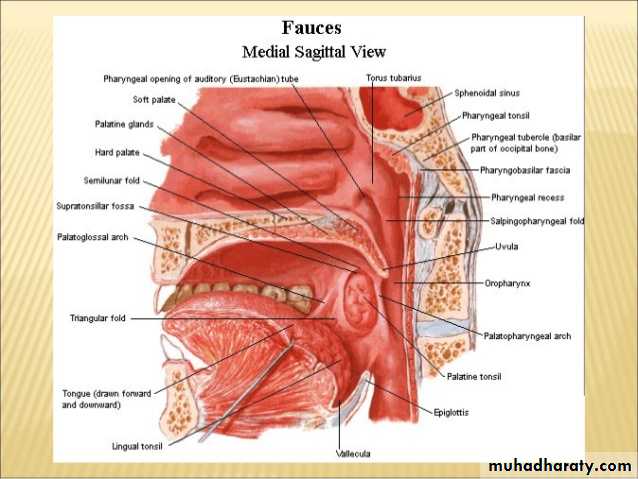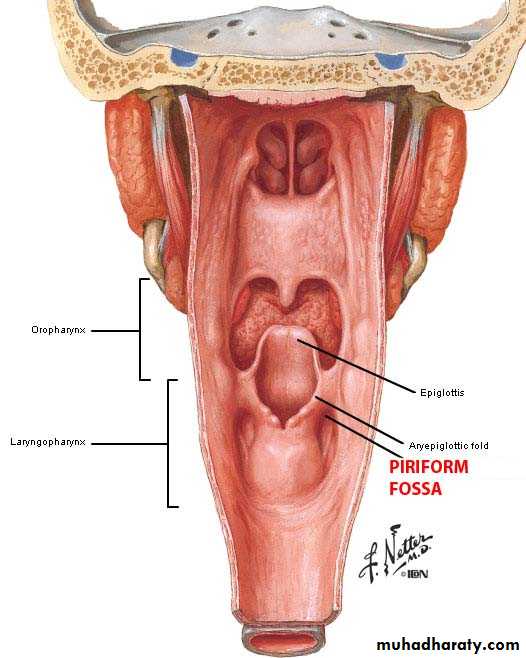Human Anatomy
تشريح / د . سيف (م 8 - 9)ثاني اسنان موصل
20/ 12 / 2015
د . سيف (م 8)
1
The Pharynx
The pharynx is the superior expanded part of the alimentary system situated behind the nasal cavities, the mouth, and the larynx and may be divided into nasal, oral, and laryngeal parts. The pharynx is funnel shaped, its upper, wider end lying under the skull and its lower, narrow end becoming continuous with the esophagus opposite the 6th cervical vertebra. The pharynx has a musculomembranous wall, which is deficient anteriorly.2
3
Muscles of the Pharynx
The muscles in the wall of the pharynx consist of the superior, middle, and inferior constrictor muscles, whose fibers run in a somewhat circulardirection, and the stylopharyngeus and salpingopharyngeus muscles, whose fibers run in a somewhat longitudinal direction.The three constrictor muscles extend around the pharyngeal wall to be inserted into a fibrous band or raphe that extends from the pharyngeal tubercle on the basilar part of the occipital bone of the skull down to the esophagus. The three constrictor muscles overlap each other so that the middle constrictor lies on the outside of the lower part of the superior constrictor and the inferior constrictor lies outside the lower part of the middle constrictor.
4
5
Parts of the pharynx
A. Nasopharynx: has a respiratory function; it is the posterior extension of the nasal cavities. The nose opens into the nasopharynx through two choanae (paired openings between the nasal cavity and the nasopharynx). The roof and posterior wall of the nasopharynx form a continuous surface that lies inferior to the body of the sphenoid bone and the basilar part of the occipital bone This part lies above the soft palate and behind the nasal cavities, it consists of no. of structures which are:6
-Openening of auditory tube: On each lateral wall of the nasopharynx there is an opening that leads into the auditory tube. This tube connects the nasopharynx to the middle ear.
-Tubal ridge: Above and behind the opening of the auditory tube the wall of the nasopharynx shows a bulging called the tubal ridge. This elevation is produced by the medial end of the cartilaginous part of the auditory tube.
-Salpingopharyngeal fold: a fold of mucous membrane starting at the tubal ridge passes down the pharyngeal wall, It covers the salpingopharyngeus muscle, which opens the pharyngeal orifice of the pharyngotympanic tube during swallowing.
7
-Pharyngeal tonsil: The mucosa of the median part of the roof shows a bulging produced by a mass of lymphoid tissue. This lymphoid tissue constitutes the pharyngeal tonsil.
-Tubal tonsil: Some lymphoid tissue is also present behind the opening of the auditory tube. This collection of lymphoid tissue is called the tubal tonsil.
-pharyngeal recess : Posterior to the tubal ridge and the salpingopharyngeal fold is a slit-like lateral projection of the pharynx, the pharyngeal recess, which extends laterally and posteriorly.
8
9
B. Oropharynx: has a digestive function. It is bounded by the soft palate superiorly, the base of the tongue inferiorly, and the palatoglossal and palatopharyngeal arches laterally. It extends from the soft palate to the superior border of the epiglottis.
Contents of oropharynx are:
-Palatoglossal arch: two ridges or folds of mucous membrane passing from the soft palate to the side of the tongue and enclosing the palatoglossus muscle.
10
-Palatopharyngeal arch: folds of mucous membrane that pass downward from the posterior margin of the soft palate to the lateral wall of the pharynx. It encloses the palatopharyngeus muscle and forms the posterior margin of the tonsillar fossa.
-Palatine tonsil:
are masses of lymphoid tissue lies between the palatoglossal and palatopharyngeal folds. The depression in which the palatine tonsil lies is called the tonsilar sinus.
11
12
C. laryngopharynx: lies posterior to the larynx, extending from the superior border of the epiglottis and the pharyngo-epiglottic folds to the inferior border of the cricoid cartilage, where it narrows and becomes continuous with the esophagus. Posteriorly, the laryngopharynx is related to the bodies of the C4– C6 vertebrae. Its posterior and lateral walls are formed by the middle and inferior pharyngeal constrictor muscles. Internally, the wall is formed by the palatopharyngeus and stylopharyngeus muscles. The laryngopharynx communicates with the larynx through the laryngeal inlet on its anterior wall.
13
Contents of laryngopharynx:
-Epiglottis:
is a thin, leaf-shaped structure at the superior border of the larynx. In its relaxed position, the epiglottis projects into the pharynx, or throat, and rests just posterior to the tongue.
-Piriform fossa (recess):
is a small depression of the laryngopharyngeal cavity on either side of the laryngeal inlet. This fossa is separated from the laryngeal inlet by the ary-epiglottic fold.
14
-Lateral glossoepiglotic fold: the fold of mucous membrane that extends from the margin of the epiglottis to the pharyngeal wall and base of the tongue on eachside, forming the lateral boundary of the epiglottic valleculae.
-Median glossoepiglotic fold:
the fold of mucous membrane that extends from the margin of the epiglottis to the pharyngeal wall and base of the tongue on each side, forming the lateral boundary of the epiglottic valleculae.
-Vallecula: a depression immediately posterior to the root of the tongue between the median and lateral glossoepiglottic folds.
15
16
17
Nerve supply of the pharynx
The nerve supply of the pharynx is through the pharyngeal plexus that is formed by branches from the glossopharyngeal, vagus and cranial accessory nerves; and from the sympathetic trunk. The fibers of the cranial accessory nerve run through the vagus and constitute the main supply of the muscles of the pharynx, including that of the soft palate.18
Blood Vessels and Lymphatics of Pharynx
The pharynx receives numerous small branches that arise from the ascending pharyngeal, lingual, facial and maxillary arteries. The veins drain into a plexus that surrounds the pharynx and drains into the internal jugular and facial veins.The lymph vessels of the pharynx drain into the deep cervical lymph nodes. Some of the lymph passes through the retropharyngeal nodes.
19






